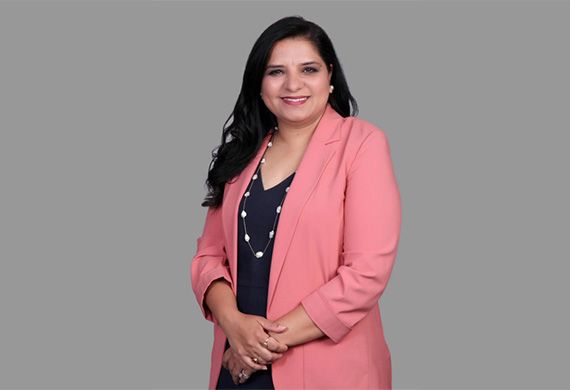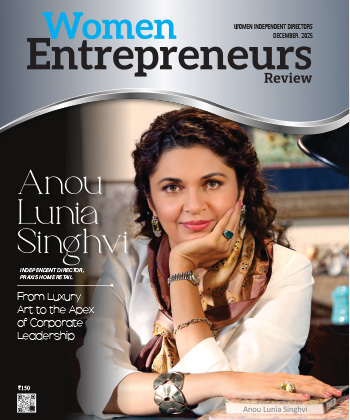
Reimagining Work: Building Agile Human-Centered Organizations
By: Deepali Bhardwaj, Regional Human Resources Director - South West Asia, IHG Hotels & Resorts
Deepali Bhardwaj is an accomplished CHRO with a strong commitment to "people first" principles. She believes that people and talent management are not just supportive functions but strategic pillars that can drive business success. With a wealth of experience across diverse industries—including hospitality, real estate, consulting, retail, consumer durables, and the non-profit sector—Deepali brings a holistic approach to human resource management, continuously adapting to the dynamic needs of the business world.
In a conversation with Women Entrepreneurs Review Magazine, Deepali sheds light on various aspects of the HR function and CHROs role. She talks about the importance of designing fluid structures within organizations, strategies for boosting purpose & productivity and more. Deepali highlights the importance of looking at inclusion from a new lens and redesigning performance ecosystems.
In today’s fluid talent market, where agility meets attrition, how can organizations design fluid structures that respond in real-time to both business volatility and human aspirations?
Today’s world is rapidly moving toward flexibility and fluidity, and organizations must adapt accordingly. COVID was a turning point—it forced companies to embrace hybrid models and rethink traditional structures.
To stay relevant, organizations need to evolve from rigid hierarchies into living systems—constantly responsive and adaptive. A major shift we’re seeing is that people will now have multiple careers in one lifetime. That requires building dynamic structures where networks replace fixed hierarchies.
For example, instead of departments working in silos—HR with HR, finance with finance—organizations should promote cross-functional, project-based teams that form and dissolve as needed. This builds stronger networks and broader skill sets. Social workplaces, where employees interact across functions and levels, also encourage continuous learning.
Roles must shift from fixed job descriptions to being outcome- and skill-oriented.
Investing in upskilling—like AI or on-demand learning—is no longer optional.
Some organizations are making progress, but more need to embed learning into their culture.
We must let go of the idea that only decades of experience qualify someone for leadership. Agile leadership models—including part-time or experimental roles—can retain talent and reduce attrition. When people are learning, they grow—and that growth drives organizational success.
The future lies not just in being flexible, but in becoming living systems—agile, connected, and always evolving.
With shifting employee expectations post-pandemic, how can experiential HR models evolve to anchor purpose and productivity in hybrid-first, cross-cultural workforces?
Purpose and productivity are closely linked. In today’s hybrid, cross-functional, and cross-cultural world, both need to evolve. As experienced architects of work, it's essential to design environments that are meaningful and flexible. And it's not just HR’s responsibility—it’s a leadership priority.
To succeed, organizations must involve employees in co-creating culture. They shouldn’t just consume policies or experiences; they should help shape them.
For example, instead of pushing top-down decisions, involve employees in designing policies and experiences. Engagement is key—without it, neither purpose nor productivity is sustainable. Purpose differs for each individual, and productivity varies person to person.
Building continuous listening systems helps. A once-a-year pulse check isn't enough. Real-time sentiment analysis can offer insights into what employees are feeling—especially in today’s digitally overloaded world. The goal is to understand the emotions people experience at work and create platforms that reflect that reality, rather than feeling mechanical.
Post-pandemic, people resist being boxed in. The hybrid model changed everything. While some governance is essential, it’s more effective to create “freedom within a framework.” Instead of rigid rules, offer guidelines and trust employees to follow them. The outcome may be the same, but the mindset and engagement differ significantly.
Purpose also requires alignment at the team level. Employees need to understand how their daily work impacts the organization. That’s where meaning is built. Organizations can support this by enabling CSR initiatives and employee resource groups aligned with individual interests. These communities help people find like-minded peers and contribute meaningfully, strengthening their connection to organizational goals.
Employee expectations will continue to evolve—and organizations must evolve with them.
Given the rise of purpose-led brands, how can CHROs co-author business growth strategies that simultaneously serve shareholder returns and social equity mandates?
Brands are increasingly becoming purpose-led, which is a significant shift. Not just CHROs, but all organizational leaders play a crucial role in this. There’s a need to build a strategic architecture that drives value—not just financial, but also social and sustainable value.
The key is to ensure actions and behaviours align with purpose. It shouldn’t be a tick-box activity; the organization must demonstrate genuine intent. That genuineness becomes visible.
Organizations are now moving towards what I call "inclusive capitalism," where purpose is driven through people, and equity is quantified—not just treated as a virtue written on a wall.
CHROs, in particular, can lead the creation of a human capital balance sheet with social metrics. Employee health, cultural well-being, and employee resource groups are also key areas. These are increasingly becoming boardroom conversations. Today, companies are focusing not just on revenue growth, but also on: Community impact; Diversity, equity, and inclusion; Innovation; and Workforce resilience. All of these can be measured and tracked—and HR plays a critical role in building and managing this architecture.
In an era where DE&I is being redefined, how can organizations embed inclusion into decision-making architecture rather than siloing it into initiatives or compliance tick-boxes?
DEI is entering a new era. It's no longer a choice for organizations—it’s a business requirement that offers clear advantages. Embedding DEI into an organization requires accountability, starting at the top.
This can't happen without a clear decision-making architecture—defining the what, how, who, and why.
Without this structure, DEI efforts risk becoming just another compliance tick box. But with defined parameters, progress becomes tangible and trackable.
Organizations must design governance models, leadership mixes, and apply an inclusion lens to all critical decision-making. This shift turns intention into action. Equally important is building cultural inclusion mechanisms that ensure psychological safety. Without it, even open conversations won't lead to change.
A practical example is a "reverse board"—a board at the base of the organizational pyramid that provides feedback to top leadership about how inclusive the culture truly is. This creates a loop of honest insights and real accountability. These steps can help organizations move from talking about inclusivity to actually living it.
As high-performance becomes synonymous with well-being, how can HR leaders redesign performance ecosystems that celebrate human sustainability, not just quarterly outcomes?
Quarterly outcomes lead to H1s, and H1s lead to annual results—H1 and H2 forming the annual cycle. That’s the usual structure. But organizations need to move beyond just managing output. Often, they ask: “What have you delivered—?” We stop seeing people as human beings and instead see them merely as task executors.
We need to move away from solely managing output and focus instead on fostering energy and resilience within the organization. When the energy is strong—marked by collaboration, trust, and adaptability—high performance becomes a natural outcome. Rather than scrutinizing output alone, our priority should be creating the conditions where great work can thrive.
Just as you can walk into a home and immediately feel that "the energy feels good," the same is true for organizations—you can sense the culture the moment you enter. That’s why cultivating the right energy and behaviors isn’t just important, it’s foundational to sustained performance.
Organizations need to focus on burnout risks, well-being, engagement scores, building an empathy index, and encouraging flexibility. Linking growth, meaning, and performance is key. Sometimes, even simple changes can make an ecosystem conducive to better outcomes. High trust leads to high growth. That’s the essence.
LAST WORD
Build your expertise, stay grounded in your perspective, and strengthen your resilience—these are among the most powerful assets women hold today. With them, you can walk into any room, anywhere, and lead with confidence.
Keep investing in your growth. And as you rise, remember to lift others with you. True success isn’t just about moving forward—it’s about bringing others along on the journey.
Most Viewed
- 1 Women's Health Startup HerMD Closing Doors Amid Industry Challenges
- 2 5 Famous Women in Indian Armed Forces
- 3 Saudi Women No longer Require Male Permission for Clothing Choices, says Prince MbS
- 4 Kolkata Medtech Startup Innovodigm Raises Rs 5.5 Crore Seed Funding Led by IAN Group
- 5 Yamunanagar's Kashish Kalra Honoured after Securing 111th Rank in UPSC Civil Services Exam
- 6 Madurai Appoints Its First Woman Corporation Head
- 7 IAS Vijayalakshmi Bidari Appointed as the new Nagpur Divisional Commissioner
- 8 American Entrepreneur Lucy Guo Overtakes T Swift to become Youngest Female Billionaire
- 9 ICC Women's World Cup 2025 Trophy Showcased at Indore's Holkar Stadium
- 10 Aparna Saxena's Beauty Venture AntiNorm Launches in India
- 11 Vidya Nataraj Co-Founded BlueStone Jewellery & Lifestyle files IPO
- 12 5 Women Freedom Fighters of India
- 13 Dr. G Krishnapriya appointed as CEO for Trichy
- 14 M3M & Sirona Partner to Introduce Menstrual Hygiene Vending Machines in 15 Locations
- 15 Punjab Govt launches SHE Cohort 3.0 Supporting Tech-led Women Startups
- 16 Indian origin Lawyer, Sweena Pannu appointed as the US New Superior Court Judge
- 17 The Aurora Tech Award recognizes 4 Indian Women-led Startups
- 18 Kerala's Republic Day parade featured an all-female tableau
- 19 Manisha Kabbur Becomes Karnataka's First Woman International Karate Coach
- 20 Director K. S. Ravikumar's Daughter Maalica Ravikumar Launches Life Coaching Company 'Evergrowth Academy' for Women
- 21 Leezu's Raises Pre-Seed Funding to Accelerate Growth in Sexual Wellness Industry
- 22 Sattu: Super-easy summer drink for PCOS gut healing
- 23 Swathi Nelabhatla creates Sitha App, India's First Women-Exclusive Gig Platform
- 24 7 Timeless Female Kathak Dancers & their Iconic Legacies
- 25 Meet 7 Iconic Women Architects of Modern India & their Most Impactful Work
- 26 This Woman-led Insuretech Startup is Helping Bridge the Education Financing Gap in India
- 27 Women Leaders Share Lessons Learnt from India Women's WC Win
- 28 5 Enterprising Women Founders Powering Singapore's Tech & Innovation Landscape
- 29 4 Women. 4 Stories. One Vision for Smarter, Stronger Healthcare
- 30 Global Gender Gap Narrows to 68.8%, But Full Equality 123 Years Away: WEF Report 2025
- 31 Changemakers: 7 Women Entrepreneurs Taking the Make in India Movement Forward
- 32 Meet Lucy Guo, The Youngest Self-Made Female Billionaire Disrupting Tech
- 33 How Women are Driving India's Festive Online Shopping Surge






